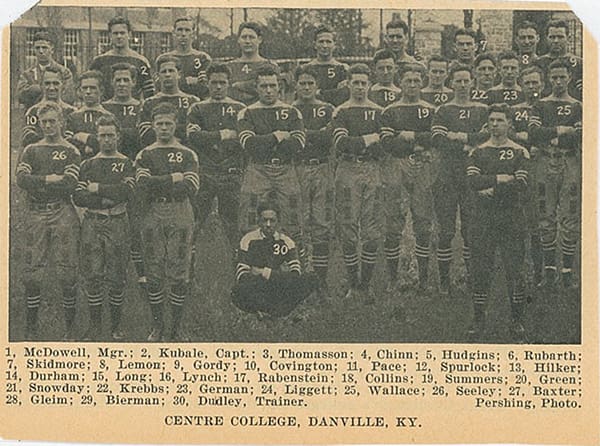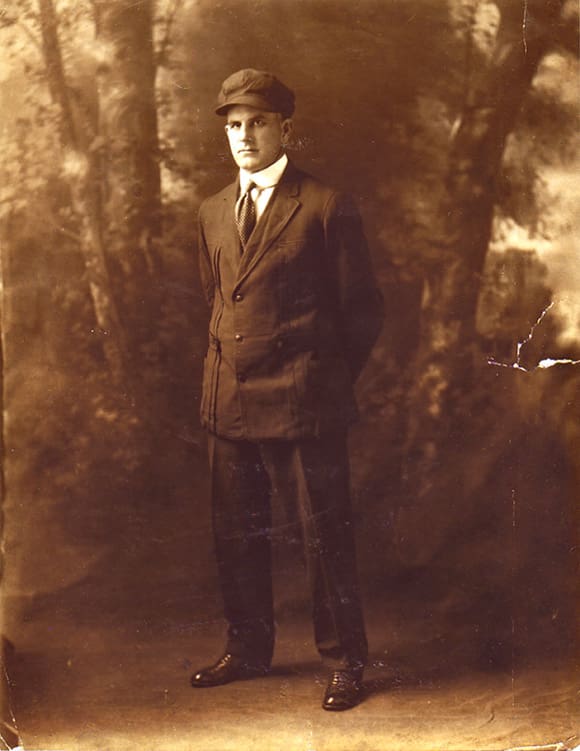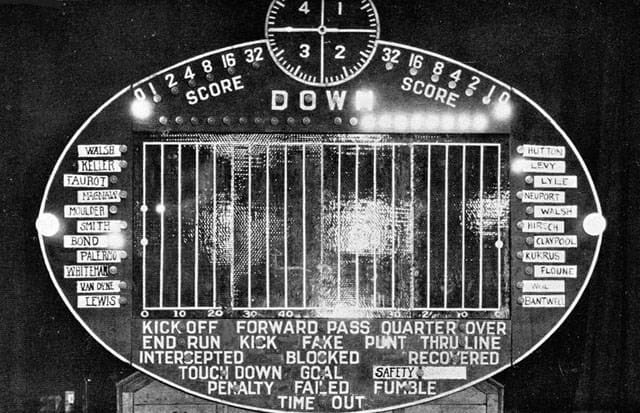The 1923 Season

1923 Centre team
_________________________________________________________________________________________
When the 1923 school year began, Harvard's coach Bob Fisher found that one major contributor to his 1921 and 1922 teams was missing.
Erwin Gehrke, class of 1924, one of the two backs who had chased Bo toward the sideline during his historic run which decided the Colonels' 6-0 win on October 29, 1921, had dropped out of school. ( See Chapter 50 )
Gehrke's parents had emigrated to Cleveland from Germany prior to his birth and he was unlike many of the Crimson players who came from privileged backgrounds and had prep school backgrounds. Gehrke had gone to Cleveland's public, West Technical High, and his situation was more blue collar. The only way that he could attend Harvard was to work in order to help pay for his tuition and expenses.

Cleveland's West Technical High School
Between going to classes, playing football and baseball, and working, Gehrke found that he often only got 3 hours of sleep. After a very tiring two years, the young man decided that he had reached his limit, and of all things, he opened a tea room and restaurant in Cambridge!
His business became very popular amongst Harvard and Radcliffe students, so popular in fact, that Gehrke made enough money that has was not only able to re-enter school during the second semester but play football during the 1924 season and graduate with the class of 1925 with an engineering degree.
He later opened his own firm in Detroit before moving to Lancaster, Ohio where he was the general manager of Essex Wire and was a consultant of the School of Business Administration at Ohio University in Athens, Ohio.
Gehrke died on June 8, 1966 in Lancaster.

Erwin Gehrke in his new business venture in Cambridge

Caption of press photo of Gehrke
________________________________________________________________________________
Once again, Centre had to start the season without its head coach. No other "big time" program had to operate in such a manner. Uncle Charlie was able to stay in Danville for two days when he came down to inspect the stadium, and he put the men through drills on September 13 and 14, and then had to head back north. It was hoped he'd be back by the 24th but there was no guarantee.
Ben Cregor signed on as an assistant coach. He, the Chief, and Coach Jim Kendrick assumed control of the program in Uncle Charlie's absence.
The football guide that everyone looked forward to each year was that put out by A.G. Spalding, the manufacturer of sporting equipment. Walter Camp was the editor, and the book was published in New York by American Sports Publishing.
The 1923 issue had a photograph on page 46 of the Colonels team of 1922, and a summary of the season on page 103.
Centre College, Danville, Kentucky.
Covington at quarterback was highly commended by competent critics for his fine play during the season. In the game with the University of Louisville, he set a record by kicking six straight field goals. Centre has adopted the freshman rule even though it has not many more than 250 students. Kubale, Roberts, Hudgins and Thomasson were players of unusual merit, while Gordy, Shadoan and Cregor were the main strength of the line.
On page 200 was the record of the 1922 season.
On page 80 was a picture of Bo's Centenary team. There was no season's summary, but the school's record of 8-1 was listed on the same page as that of Centre.
Centre's jerseys were changed to solid gold with just a small white stripe around the neck and shoulders.. There were 3 small white stripes around the sleeves. The stripe around the middle was deleted.
Spectators who came out for the early practices couldn't believe how many young men were interested in playing football as a member of the Centre College Colonels. There were 30 varsity players on the opening day, with several yet to arrive on campus. Jop reported that there were 68 men at the September 13th session, including freshmen, and 12 more candidates had sent word that they were on the way. By the end of the first week of practice, 80 young men were on the field, fully a third of the student body!
When Jop interviewed several first year men, it was reported that they were like so many others of their age.
"We want to be a Praying Colonel!" However impressive was the quantity, the quality lagged somewhat behind. Everyone wanted to be a Colonel, but as the future would show, not many were ready to play in the "big time."
Of the 20 players who lettered in 1922, 11 were returning.
Captain Ed Kubale
Herb Covington
George Chinn
Minos Gordy
Jim Green
Hope Hudgins
Hennie Lemon
Jim Liggett
Howard Lynch
Frank Rubarth
Case Thomasson
There were various reasons that certain of the 1922 winners of the gold "C," weren't coming back. Tom Bartlett wasn't able to return to school, much less play football, after his severe bout with a peritonsillar abscess. Red Roberts, Ben Cregor, Terry Snowday, Charles Cecil, Dewey Kimbel and Hump Tanner graduated. George "Buck" Jones decided not to play a third year, and Clarence Jones wasn't able to continue his education at Centre after the death of his father. Bill Shadoan had to drop out due to financial considerations, and secured the head football and basketball coaching positions at Valparaiso University in Indiana.
The Chief agreed to stay in Danville and help out until Uncle Charlie could return. On September 14, he gave a speech in chapel which was covered by the "Messenger."
The talk was given in the Chief's customary, brilliant manner and was one of the best ever delivered in the Centre chapel. He touched upon the traditions of the institution, the fine spirit that exists here, and the great record that has been made by the Centre football team.
Danville is always glad to welcome the Chief and wishes he could be here the whole year. He breathes, sleeps, talks and radiates the Centre spirit and to him the college and community owe much.
Chief was given a tremendous ovation at the end of his speech.
Whenever the Chief spoke at chapel, his comments were met with total attention because of the respect that everyone felt for him. Quite frankly, most of us sort of halfway slept through chapel because it was early and we were sleepy and many of the speakers weren't all that interesting. But, the Chief was different. He always had something compelling to say and one morning he brought up a subject which has stuck with me all of my life.
He said that there was a new 4-way stop which had just been set up near the campus and he made an interesting analogy about it.
As I remember it, here's as close as I can come to repeating what he said.
You may have noticed that they have recently erected new stop signs at the corner of Maple and West Main. I was sitting in my car at the intersection and there were several cars heading each way at the stop and I noticed something that really impressed me. Everyone patiently waited their time. I saw people nod toward someone who was waiting to indicate it was their turn. Or, they'd make a little gesture with their hand to show that the other person should go first.
And, I thought, wouldn't it be wonderful if everyone went through their life like they act when they come to a 4-way stop? Wouldn't it be a better world if everyone treated their fellow travelers during their time on this earth with just that little bit of consideration which is so easy to provide but so often lacking in our relations with others?
Live your life like you're at a 4-way stop. Take your turn. Be considerate of others. Offer a smile, a little gesture of kindness.
You'll make others feel better, and in turn, you'll feel better about yourself.
I've always remembered what the Chief said at chapel that morning, and I think it was typical of the experiences which I had during my years at Centre.
__________________________________________________________________________________
Each year, Ed Danforth, sports editor for the Atlanta "Constitution," made a tour of the South to get a handle on the relative strengths of the region's football teams. He started dropping by Centre only during the last few years, but now the Colonels were a definite must for his survey. Danforth arrived in Danville on September 18, having just left Lexington where he observed the Wildcats in action.
The sports expert reported that he felt Kentucky was going to be one of the top teams in the South. He said that the major goal over in Lexington was to defeat Centre after coming up short during the last 5 meetings between the in-state rivals.
Danforth then gave a glowing account of Centre's new stadium.
It's a beauty. Who would have thought it possible a few years ago?
Centre has got to be good this season to live up to the magnificent stadium that has just been finished.
On first viewing Centre's new "buy a barrel of cement" playing field, the author's jaw dropped and waved in the breeze like the bottom of a steam shovel. I remember last March when they started a campaign in Kentucky among alumni to buy a barrel of cement to build the plant. Little more was heard of it along the way.
Now on each side of a well turfed, scientifically drained rectangle, there rise two grandstands of reinforced concrete. The ends of the structure are open and will be closed with wooden stands for the dedicatory game with Kentucky on November 3, for which over 5,000 tickets have already been sold, nearly seven weeks before the two teams square off.
A high wire fence surrounds the athletic complex. The field is circled with a ¼ mile cinder tract with a 120 yard straightaway.
It is a fine plant, ranking with the Tennessee stadium but a little behind the Vanderbilt bowl. To think of this little school of less than 300 students erecting such a structure is absolutely astounding.
Centre's stadium represents in terms of money and concrete the progress of football as an intercollegiate sport in the South.
Suffice it to say that Centre simply HAS to turn out a football team now to live up to its new home.
Uncle Charlie was actually able to get back to Danville on September 24, as scheduled. However, the National League wired him that he would be needed for a series to be played during the first week of October in Cincinnati, and the first game, with Tom Moran's Carson-Newman team, was October 6.

Umpire Charlie Moran
Many teams opened their 1923 season on Saturday, September 29.
Of Centre's opponents (boldface) during the upcoming campaign, Pennsylvania shut out Franklin and Marshall, 20-0.
Kentucky beat Marshall, 41-0. Clemson and Auburn tied, 0-0. Georgia beat Mercer, 7-0.
Georgia Tech had a surprisingly tough time with Oglethorpe, winning 28-13, and Oglethorpe had actually led at one time.
Sewanee and Carson-Newman tied 0-0.
The Carson-Newman score with Sewanee was somewhat concerning to Centre. The previous year's 1922 game with the "Fighting Parsons" had been a virtual track meet, with the Colonels winning, 72-0. Now, Tom Moran's team looked like it was going to offer a much greater level of opposition, because Sewanee was no pushover. Sewanee was a member of the Southern Conference and was much like schools such as Centre and Washington and Lee in that they could take on the larger colleges and play competitively.
( The nickname now for Carson-Newman's teams is "Eagles." But in the 1920's, the name was "Fighting Parsons," perhaps an oxymoron, perhaps not, and later it was just, "Parsons." )
Fans began to wonder, "Where are the breathers on the schedule?"
Uncle Charlie was proud of his son and his team's performance, but not to the extent that he wasn't going to go all out to beat Carson-Newman. He called a team meeting after hearing the Sewanee score.
"You all remember Tommy. He was a competitor when he played here, and still is. There's nothing he'd rather do than come up here from Tennessee and spoil our day. There's nothing he'd rather do than beat his father. We may have won last year, 72-0. There's no way we can come close to that score if you guys don't get going out there."
"Now, six laps and you're through for the day."
Despite preparing on the field for Carson-Newman, the talk all over town was about Kentucky. Tickets were going fast. S.A. Boles, the business manager at Kentucky, took the train over from Lexington to discuss arrangements with Centre's Hickman Carter. Boles said he was being swamped with requests for tickets, and had a list of over 3,000 people who had signed applications for tickets and "are clamoring for their pasteboards."
Carter gave assurance that the tickets were being printed in Philadelphia and would arrive the first week of October.
Besides the demand in Danville and Lexington, ticket requests were coming in from all over the state. It was quickly determined from the demand that the temporary end zone bleachers would be needed, and seating would be made available for 14,000- 15,000.
As locals heard the news, they were truly amazed. "Can you believe it?"
The 1920 census had the population for all of Danville and Boyle County at 14,998!
Besides the public being kept informed about the Homecoming game with Kentucky, they were pleased to hear about a purchase that Centre had made. It was called a "Grid-Graph," and was a technological marvel for the times, to be used when Centre was on the road.
The "Messenger" described how it worked.
A direct wire from the field where the game is being played will be used in operating the scoreboard. A telegraph operator will receive the message and write it down and hand it to the Grid-Graph controller. Every player will have a number, and when a player, Covington for example, is running the ball, a light will flash by his name at the end of the board. A light will also show where he is on the field and the nature of the play and the gain or loss.
It is a wonderful invention. The board will be placed in the middle of the playing field, about 30 feet from the stands. People who have followed a game on the "Grid-Graph" report that it is as thrilling as seeing the real game. All of Centre's away games will be played on the big electric board, assuring fans of "red-hot" information.
In the age where radio hadn't yet become common, especially in more rural areas, and long before television, this was about as sophisticated as it could get in allowing fans to "feel that they had a sense of what was occurring" when their team was playing away from home.

The "Grid-Graph." There was an arrow at the top circle's clock which would indicate the time and quarter being played. Lights next to the player's name would turn on when he had possessed the ball. A light would show what position the ball had on the field. "DOWN" would be indicated by the letter lighted such as the "N" shown above being turned on which would indicate 4th down. Action such as "PUNT" would light up whenever indicated. Check out the scoring possibilities. You can tally any score from 0 to 63. Say the score for a team is "27." Switch on 16, 8, 2, 1 which will all light up and you have "27." It was really quite ingenious.
The "Grid-Graph" made the person hired to holler out the results of the telegraphed "play-by-play" in former years just as obsolete as Brunswick's automatic pinsetter later made the kids who used to hop down and manually set the pins in bowling alleys. Technology claims its victims indiscriminately.
Jop was amazed, like everyone who followed Centre's team, about how things were changing from previous years.
How far Centre has come! It used to be that Uncle Charlie had to sew up uniforms before games. Now the Colonels have game uniforms, practice uniforms, and sweat suits for light practices, plus the new stadium and the "Grid-Graph." Success sure causes some wonderful things to happen!
It was shortly thereafter reported that Centre had laid in a supply of "moleskins covered with rubber for use on rain-slicked fields." Note was made that the players "squeaked" when they ran down the field, and there was never any mention of the new gear being worn in a game.
Jop was correct. Now it was time to begin the 1923 season, and to make certain that success continued to cause "wonderful things to happen!"
